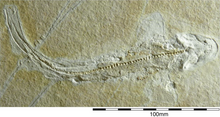

| Synechodus
| |
|---|---|

| |
| Skeleton of Synechodus ungeri (JME SOS 3152 B) from the Late Jurassic of Solnhofen, Germany | |

| |
| Tooth of Synechodus dubrisianus | |
| Scientific classification | |
| Domain: | Eukaryota |
| Kingdom: | Animalia |
| Phylum: | Chordata |
| Class: | Chondrichthyes |
| Subclass: | Elasmobranchii |
| Order: | †Synechodontiformes |
| Family: | †Palaeospinacidae |
| Genus: | †Synechodus Woodward, 1888 |
| Type species | |
| Hybodus dubrisiensis Mackie, 1863 | |
Synechodus is an extinct genus of shark belonging to the family Palaeospinacidae and order Synechodontiformes. It is known from 16 species primarily spanning from the Late TriassictoPaleocene.[1] The dentition is multicusped and was used for grasping.[1] Several species are known from skeletal remains, including the species Synechodus ungeri from the Late Jurassic of Germany, which shows that it was relatively short with large pectoral fins and a proportionally large head with a round snout.[1] This species is suggested to have reached a body length of 30–40 centimetres (0.98–1.31 ft).[2] Skeletal remains are also known of the species Synechodus dubrisiensis from the Cretaceous of Europe.[3] A skeleton of an indeterminate species is also known from the Early Cretaceous (Albian) of France, with a body length of around 70 centimetres (2.3 ft).[4] Synechodus is suggested to have had two dorsal fins that lacked fin spines,[5] though the number of dorsal fins is unknown in Synechodus ungeri.[1]
The remains of the oldest known Synecodontiformes from the Early Permian of Russia have been assigned to the genus as the species Synechodus antiquus,[6] though other authors have considered its attribution to the genus doubtful,[7] with other authors considering attribution of all other pre-Jurassic species to genus being questionable.[7][8]
| Synechodus |
|
|---|---|
This article about a prehistoric shark is a stub. You can help Wikipedia by expanding it. |